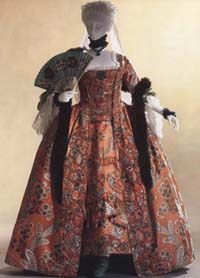
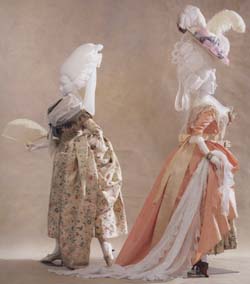
The In's and Out's of The 18th Century Fashion World
 |
These dresses represent
the two different nations. The dresses are named for their place of origin,
and share many similarities. The important distinction of these dresses
is that they signify the turn-around that occured half-way through the
century. It was during the mid to later 1700's that the French began looking
to the English for their fashion trends, instead of the other way around.
While Paris may have been the mecca for fashion coniseours previously,
the growth of neoclassicism went hand in hand with the more informal styles
of the English nobility. Rococo went out the window, and with it went
some esteem for French ideals.
|
 |
| Circa 1760--Robe a la francais (10) | Circa 1785--Robe a l'anglaise (10) |
|
Circa 1765--French (10) |
The
dress and petticoat shown here are examples of the pervasiveness of chinoiserie
during the 1700's. During the Rococo period, detail was crucial to any fashionable
lady. The more ornate the material, the better.
|
Petticoat Detail--Circa 1720--English (10) |
|
The dress on the left displays the technique of chine, a method of printing patterns onto cloth. It was so difficult to produce this form of dress that it was done only in France. It is the same technique as the Japanese Hogushiori, and was popular as a summer dress for noblewomen all over Europe. (10) Chinese flowers and symbols have been incorporated into the appliqued embroidery of the petticoat above right. Here we see the fusion between the British love of chinoiserie and their love of fashion. |
||
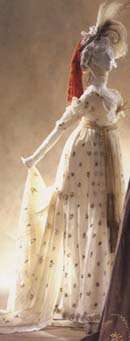 |
Stripes were everywhere as Europe turned from Rococo to Neoclassicism. Some were copied from the outfits of Japanese sailors on board the trading ships. In this case, The East India Company imported this muslin to England, where it was then worked into the fashion seen here. Cotton, silk, chintz, and muslin all came into Europe through trade with India. Eventually, the fabrics became so popular that factories for making them sprung up all over Europe. In addition, many fabrics derived from foreign countries were banned during the early 18th century, in an effort to keep Europeans buying materials in their own land. An important note for the era is that while fans of Rococo were always on the lookout for new, more daring ideas, they were not as interested in obtaining any real knowledge about the places from which they recieved their goods. Therefore, Chinese and Japenese designs were often muddled together by fashion-minded dressmakers. The result is a confusing mix of imported trends, which perhaps best suits the ideals of the Rococo period. |
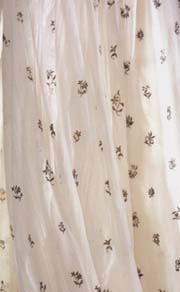 |
| Circa 1795--English (10) | Detail of Dress at Left--Indian Muslin (10) |
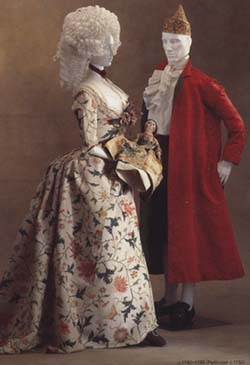 |
We might designate this couple as, "Typical English Nobles." In truth, their costumes reflect the major trends held dear during the 18th century. The dress is in the English style, leaning more towards neoclassicism than rococo; The fabric for the dress is Chinese hand-painted silk. The man's dress is called a 'Banyan', a sort of robe for wearing at home. It is made of Chinese silk as well. The banyan is believed to be derived from the gowns worn in India, and was another import from The East India Company. The whirlwind frenzy of trade that highlighted the century produced clothing with a little bit of everything. Akiko Fukai, inRevolution In Fashion, remarked, "On one banyan, cherry and pine trees in Japanese Yuzen style were painted in India on Indian cotton. By such subtle means, the culture of Japan was being spread throughout Europe, often without specific recognition." |
| Circa 1780-85--English (10) |